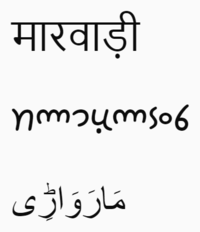
Back Marwari Afrikaans مارواري Arabic Idioma marwari AST مارواری دیلی AZB Марвары Byelorussian মারোয়াড়ি ভাষা Bengali/Bangla Marwareg Breton Idioma marwari Catalan زمانی مارواری CKB Marwari (Sprache) German
This article needs additional citations for verification. (August 2014) |
| Marwari | |
|---|---|
 | |
| Pronunciation | [mɑɾvɑɽi] |
| Native to | India, Pakistan |
| Ethnicity | Marwari |
Native speakers | 21 million, total count (2011 census)[1] (additional speakers counted under Hindi)[2] |
| Devanagari (in India) Perso-Arabic (in Pakistan) Mahajani (historical) | |
| Language codes | |
| ISO 639-2 | mwr |
| ISO 639-3 | mwr – inclusive codeIndividual codes: dhd – Dhundarirwr – Marwari (India)mve – Marwari (Pakistan)wry – Merwarimtr – Mewariswv – Shekhawatijog – Jogigdx – Godwarigig – Goarialrk – Loarkigda – Gade Lohar (duplicate of Loarki)mki – Dhatki |
| Glottolog | Noneraja1256 scattered in Rajasthani |
 Dark green indicates Marwari speaking home area in Rajasthan, light green indicates additional dialect areas where speakers identify their language as Marwari. | |

Marwari (मारवाड़ी, ماروارؕی, Mārwāṛī)[a] is a language within the Rajasthani language family of the Indo-Aryan languages. Marwari and its closely related varieties like Dhundhari, Shekhawati and Mewari form a part of the broader Rajasthani language family. It is spoken in the Indian state of Rajasthan, as well as the neighbouring states of Gujarat and Haryana, some adjacent areas in eastern parts of Pakistan, and some migrant communities in Nepal.[4][5][6] There are two dozen varieties of Marwari.
Marwari is popularly written in Devanagari script, as are many languages of India and Nepal, including Hindi, Marathi, Nepali, and Sanskrit; although it was historically written in Mahajani, it is still written in the Perso-Arabic script by the Marwari minority in Eastern parts of Pakistan (the standard/western Naskh script variant is used in Sindh Province, and the eastern Nastalik variant is used in Punjab Province), where it has educational status but where it is rapidly shifting to Urdu.[7]
Marwari has no official status in India and is not used as a language of education. Marwari is still spoken widely in Jodhpur, Pali, Jaisalmer, Barmer, Nagaur, Bikaner.
- ^ Marwari at Ethnologue (26th ed., 2023)

Dhundari at Ethnologue (26th ed., 2023)
Marwari (India) at Ethnologue (26th ed., 2023)
Marwari (Pakistan) at Ethnologue (26th ed., 2023)
Merwari at Ethnologue (26th ed., 2023)
Mewari at Ethnologue (26th ed., 2023)
Shekhawati at Ethnologue (26th ed., 2023)
(Additional references under 'Language codes' in the information box) - ^ "Statement 1: Abstract of speakers' strength of languages and mother tongues - 2011". www.censusindia.gov.in. Office of the Registrar General & Census Commissioner, India. Retrieved 7 July 2018.
- ^ Ernst Kausen, 2006. Die Klassifikation der indogermanischen Sprachen (Microsoft Word, 133 KB)
- ^ Frawley, William J. (1 May 2003). International Encyclopedia of Linguistics. Oxford University Press. ISBN 978-0-19-977178-3.
Marwari : also called Rajasthani, Merwari, Marvari. 12,963,000 speakers in India and Nepal. In India: Gujarat, Rajasthan, Madhya Pradesh, Punjab, Delhi, Haryana, Uttar Pradesh, throughout India. Dialects are Standard Marwari, Jaipuri, Shekawati, Dhundhari, Bikaneri.
- ^ Upreti, Bhuwan Chandra (1999). Indians in Nepal: A Study of Indian Migration to Kathmandu. Kalinga Publications. ISBN 978-81-85163-10-9.
- ^ "Marwari Mahotsav 2018". ECS NEPAL. Retrieved 16 June 2022.
- ^ "Pakistani Marwari". Ethnologue. Retrieved 4 September 2019.
Cite error: There are <ref group=lower-alpha> tags or {{efn}} templates on this page, but the references will not show without a {{reflist|group=lower-alpha}} template or {{notelist}} template (see the help page).